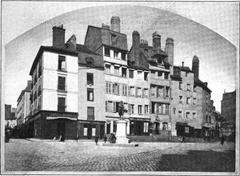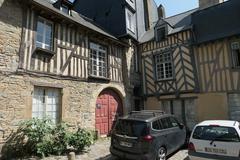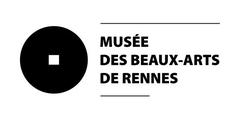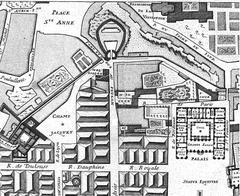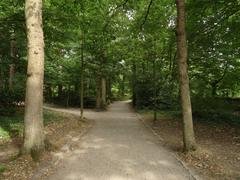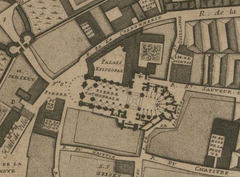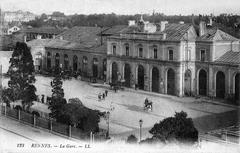Sarcophagus D2003.0010.1: Visiting Hours, Tickets, and History in Rennes, France
Date: 03/07/2025
Introduction
Rennes, the historic capital of Brittany, is renowned for its vibrant cultural scene and deep-rooted heritage. Among its treasures is the Sarcophagus D2003.0010.1, an exceptional early medieval artifact that offers insight into Merovingian funerary customs and social hierarchies. This comprehensive guide explores the sarcophagus’s origins, artistic and symbolic significance, and provides all the practical information you need—opening hours, ticketing, accessibility, and guided tours—to plan your visit.
Sarcophagi in Rennes reflect a confluence of Egyptian, Roman, and early Christian traditions, uniquely adapted to the Breton context and visible in the Merovingian style of D2003.0010.1. The sarcophagus is housed at the Musée de Bretagne within the Les Champs Libres cultural complex, bridging the late Roman and early medieval Christian eras (National Geographic, Rennes Tourist Office). Visitors can immerse themselves not only in this artifact, but also in the wider historical tapestry of Rennes, including its medieval architecture, other museums, and historic sites (France This Way).
Table of Contents
- Origins and Evolution of Sarcophagi
- Sarcophagi in Roman and Early Christian Rennes
- Medieval Sarcophagi in France and Brittany
- Artistic and Symbolic Importance
- Sarcophagi in Rennes: Historical Context
- Visiting the Rennes Sarcophagus and Related Sites
- Discover the Sarcophagus (D2003.0010.1) in Rennes: A Window into Early Medieval History
- Visiting Rennes: Hours, Tickets, and Must-See Historical Sites in Brittany
- Visiting the Sarcophagus at Musée de Bretagne: Opening Hours, Tickets, and Sites Guide
- Location and Access
- Museum and Sarcophagus Visiting Hours
- Navigating the Musée de Bretagne
- Viewing the Sarcophagus
- Interpretive Materials and Educational Resources
- Visitor Tips for Tickets and Timing
- Explore Nearby Rennes Historical Sites
- Dining and Refreshments
- Safety, Security, and Sustainable Tourism
- Booking Tickets and Contact Information
- FAQ
- Conclusion
- Further Resources and Engagement
Origins and Evolution of Sarcophagi
The term “sarcophagus” derives from the Greek sarx (flesh) and phagein (to eat), referencing the belief that certain stones accelerated decomposition (National Geographic). The earliest stone sarcophagi, dating to Egypt’s 3rd Dynasty (c. 2686–2613 BCE), were reserved for royalty and elites and often mimicked palatial forms, symbolizing eternal homes for the dead.
This tradition spread through ancient Greece and Rome. Greek sarcophagi featured mythological scenes, while Roman sarcophagi, particularly from the 2nd century CE, are noted for their marble construction and intricate reliefs (Algor Education).
Sarcophagi in Roman and Early Christian Rennes
In the Roman era, sarcophagi were status symbols for the wealthy, decorated with mythological and personal motifs (National Geographic). As Christianity spread in the 3rd and 4th centuries CE, the iconography transitioned to biblical themes and symbols of resurrection, and sarcophagi found their place in catacombs and church crypts (Algor Education).
Medieval Sarcophagi in France and Brittany
During the early Middle Ages, stone sarcophagi were used throughout Western Europe. Discoveries near Paris (e.g., Corbeil-Essonnes) and in Brittany reveal their use among the nobility and clergy (All That’s Interesting). In Brittany, religious sites like Angers’ abbeys housed sarcophagi for saints and bishops, underscoring their spiritual and social importance (Angers History).
Artistic and Symbolic Importance
Sarcophagi were more than burial containers—they were artistic expressions. Egyptian examples were decorated with protective motifs, while Roman and early Christian sarcophagi showed narrative reliefs and religious imagery. Medieval French sarcophagi, including those in Rennes, often bore Christian symbols and sculpted effigies reflecting the deceased’s status (National Geographic, Algor Education).
Sarcophagi in Rennes: Historical Context
Rennes, with over 2,000 years of history, is a showcase for both medieval architecture and funerary traditions (France Voyage). The sarcophagus D2003.0010.1 follows a regional tradition associating sarcophagi with ecclesiastical and elite burials (Angers History). Recent finds throughout western France, such as Frankish sarcophagi in Angers, contextualize Rennes’s place in early medieval funerary history.
Visiting the Rennes Sarcophagus and Related Sites
Visiting Hours and Tickets
The Sarcophagus D2003.0010.1 is displayed at the Musée de Bretagne and sometimes at the Musée des Beaux-Arts de Rennes. Standard visiting hours are 10:00 AM–6:00 PM, Tuesday to Sunday. Regular admission is around €7, with concessions available. Up-to-date details can be found on the Tourisme Rennes website.
Accessibility
Both museums are fully accessible, with assistance for visitors with reduced mobility, and audio guides in multiple languages.
Guided Tours and Special Events
The Rennes Tourist Office arranges guided tours of churches, cemeteries, and archaeological exhibits. Book ahead during busy periods for special events or temporary exhibitions.
Travel Tips and Nearby Attractions
Rennes is easily navigable by foot, train, or bus. Don’t miss the Parlement de Bretagne, Thabor Gardens, and Saint-Pierre Cathedral for a full cultural experience.
Frequently Asked Questions (FAQs)
Q: What are the visiting hours for the Rennes sarcophagus exhibits?
A: Typically 10:00 AM–6:00 PM, Tuesday–Sunday. Always check the museum’s website for current details.
Q: Are tickets required?
A: Yes, admission is ticketed. Purchase online or at the entrance.
Q: Is photography allowed?
A: Usually, but flash is prohibited. Confirm on site.
Q: Are guided tours available?
A: Yes, through the Rennes Tourist Office and museums.
Q: How accessible are the exhibits?
A: Fully accessible, with support for visitors with disabilities.
Discover the Sarcophagus (D2003.0010.1) in Rennes: A Window into Early Medieval History
Historical Background
The Sarcophagus D2003.0010.1 is a Merovingian artifact (5th–8th centuries CE), representing the elite burial practices of the period. Merovingian sarcophagi are typically austere, emphasizing status and preservation over decoration (Mapcarta, U Speak Greek, Egyptian History).
Archaeological and Cultural Significance
This sarcophagus illustrates Rennes’s prominence as a religious and administrative hub. Its simplicity reflects the transitional period between Roman and Christian traditions, emphasizing permanence and legacy (Egyptian History).
Location and Accessibility
Located in the Les Champs Libres complex, the Musée de Bretagne is centrally situated and easily reached by public transport (Rennes Tourist Office, The Crazy Tourist). English-speaking staff and bilingual signage facilitate international visits.
Visiting Hours and Tickets
Open year-round, 10:00 AM–6:00 PM (check for seasonal changes). Admission is €5–€8, with discounts and occasional free entry on the first Sunday of the month (Musée de Bretagne website).
Museum Experience and Practical Tips
- Fully accessible (ramps, elevators, restrooms)
- Café, gift shop, and reading areas on site
- Photography generally allowed (no flash or tripods)
Guided Tours and Educational Programs
Regular guided tours and hands-on workshops are available for all ages (The Crazy Tourist).
Contextualizing the Sarcophagus
Rennes’s medieval center boasts over 90 historic monuments (France This Way). Pair your visit to the sarcophagus with the Saint-Pierre Cathedral, medieval quarter, or city ramparts (AtickettoTakeoff).
FAQ: Sarcophagus Visit
- Visiting hours? 10:00 AM–6:00 PM; check website.
- Tickets? €5–€8; discounts available; some free days.
- Accessibility? Full.
- Guided tours? Yes.
- Photography? Allowed, with restrictions.
Plan Your Visit: Tips
- Always verify hours and ticket info (Musée de Bretagne website, Rennes Tourist Office)
- Combine your visit with other landmarks (Ab in den Urlaub)
- Join guided tours for deeper understanding
- Explore local cuisine and culture after your museum visit (France This Way)
Visiting Rennes: Hours, Tickets, and Must-See Historical Sites
Historical and Cultural Context
Rennes’s medieval core reflects centuries of history and cultural resilience (Voyage Tips). As the former Breton parliament seat, it remains a hub of Breton culture.
Architectural Heritage
Explore the mix of medieval, Renaissance, and 18th-century architecture, including Place des Lices and Parliament of Brittany (Travelling King). Parc du Thabor and street art add contemporary flair.
Museums and Cultural Institutions
- Musée des Beaux-Arts de Rennes: 10 AM–6 PM, Tue–Sun. €6; free select days (WhichMuseum).
- Musée de Bretagne: 10 AM–6 PM, Tue–Sun. €5; discounts/free days.
- Espace des Sciences: Great for families.
Practical Information
- Compact city center; easy to walk or use public transport.
- Rennes Citypass offers access to museums, tours, and more.
- Best visited in spring or early autumn.
Special Events and Guided Tours
Enjoy festivals like Trans Musicales, guided tours, and prime photography spots such as Rue du Chapitre and Parc du Thabor.
Nearby Attractions
Day trips include Dinan, Mont Saint-Michel, and Saint-Malo.
Safety and Travel Tips
Rennes is safe and welcoming. Wear comfortable shoes for cobblestone streets and pack for variable weather (Travelling King).
FAQ
- Museum hours? 10 AM–6 PM, Tue–Sun.
- Tickets? €5–€6; free first Sundays.
- English support? Audio guides available.
- Guided tours? Book via Tourist Office.
- Transport? Metro, bus, and walkable center.
Visiting the Sarcophagus at Musée de Bretagne: Your Complete Guide
Location and Access
The sarcophagus is at Musée de Bretagne, Les Champs Libres, 10 Cours des Alliés, 35000 Rennes, easily accessible from the train station and by local transport (France This Way).
Museum and Sarcophagus Visiting Hours
Open Tuesday–Sunday, 10:00 AM–6:00 PM. Closed Mondays and select holidays. Admission is affordable, with concessions; combination tickets are available for more museums (France This Way).
Navigating the Museum
Signage and accessibility features (elevators, ramps) are in place. The sarcophagus is in the archaeological section, with bilingual panels and audio guides. Guided tours are available.
Viewing the Sarcophagus
Displayed in a climate-controlled setting with interpretive materials. Photography is allowed without flash.
Educational Resources
Detailed placards, digital kiosks, and workshops are offered, especially during holidays (France This Way).
Visitor Tips
- Visit during weekday mornings for fewer crowds.
- Book tickets online in advance for peak times.
- Full accessibility, including tactile models and braille guides.
- Café, bookshop, free Wi-Fi, and lockers on site.
Explore Nearby Sites
After the museum, visit the medieval quarter, Portes Mordelaises, and Rennes Cathedral. Musée des Beaux-Arts is in the same complex.
Dining
Enjoy the museum café or local Breton cuisine at Place Saint-Anne (France This Way).
Safety and Sustainable Tourism
The museum is secure and promotes sustainability with energy-efficient lighting and recycling.
Booking Tickets
Book online or at the desk. Group visits and special accommodations can be arranged. Information is available on the Musée de Bretagne’s website.
Summary and Final Recommendations
The Sarcophagus D2003.0010.1 is a gateway to Rennes’s early medieval past, reflecting Merovingian social and artistic transitions. Housed at the Musée de Bretagne, it is accessible to all visitors and surrounded by a city rich in historic and cultural attractions (Musée de Bretagne, Rennes Tourist Office). For an enriching experience, plan ahead, make use of accessibility features, and explore nearby sites. Stay informed and enhance your visit with audio guides and official resources (France This Way, National Geographic).
References and Further Reading
- Exploring the Sarcophagi of Rennes: History, Significance, and Visitor Information, 2025, National Geographic (National Geographic)
- Discovering the Sarcophagus (D2003.0010.1) in Rennes, 2025, Rennes Tourist Office (Rennes Tourist Office)
- Visiting Rennes: Hours, Tickets, and Must-See Historical Sites in Brittany, 2025, France This Way (France This Way)
- Visiting the Sarcophagus at Musée de Bretagne: Opening Hours, Tickets, and Rennes Historical Sites Guide, 2025, France This Way (France This Way)
- Rennes Historical Context and Archaeological Findings, 2025, Angers History (Angers History)
- Museum of Fine Arts of Rennes Information, 2025, WhichMuseum (WhichMuseum)


